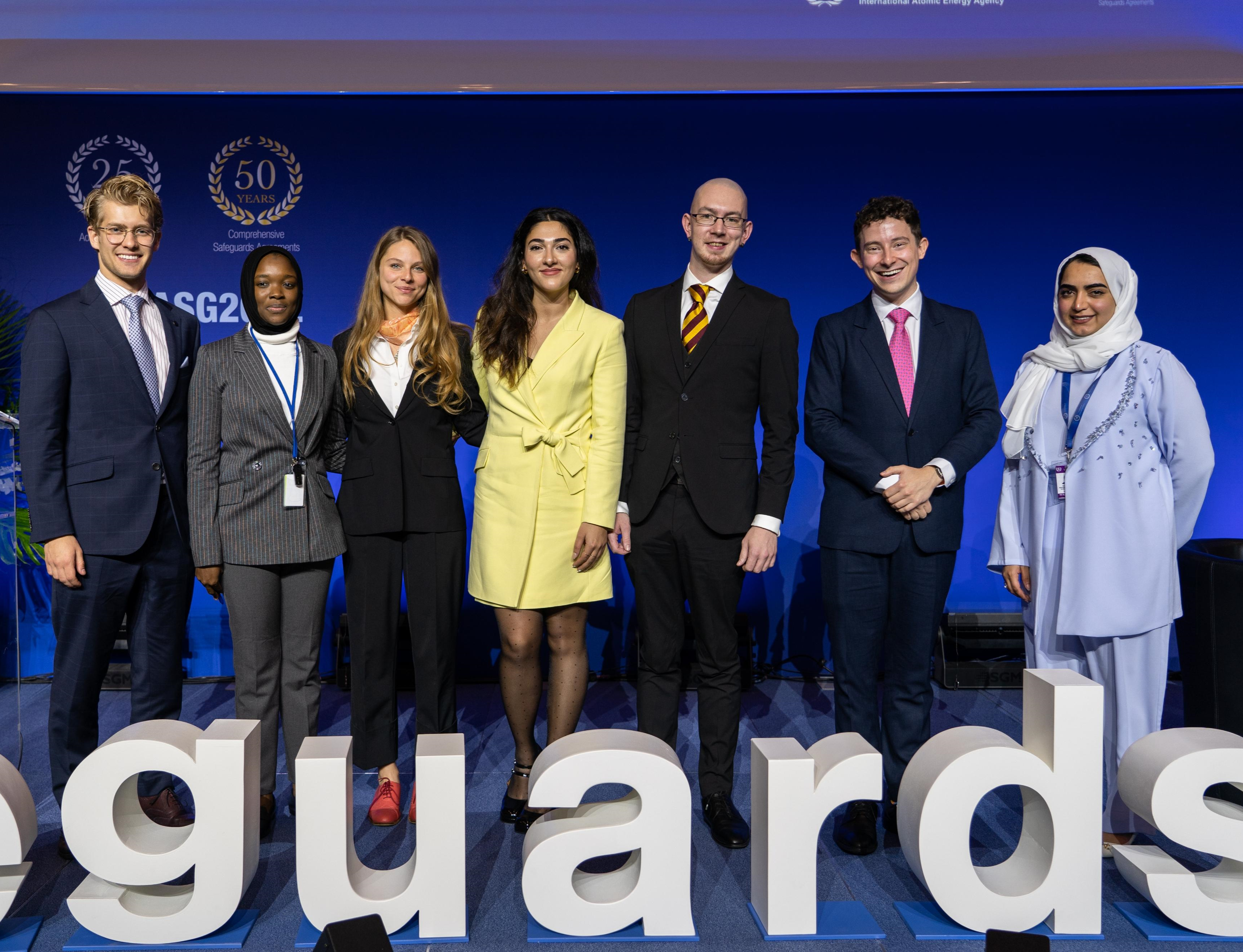
From 31 October to 4 November 2022, the International Atomic Energy Agency (IAEA) held its quadrennial Symposium on International Safeguards in Vienna, Austria. Hundreds of safeguards experts from diplomatic missions, international capitals and non‑governmental organisations met at the Symposium to reflect on the development of safeguards and anticipate the future ahead.
Experts from the VCDNP played an active role in the symposium, speaking in nine panel discussions, moderating two sessions and submitting four papers for the meeting.
Executive Director Elena K. Sokova presented lessons learned from the VCDNP’s activities in safeguards capacity building in a session entitled “Safeguards Vanguards: Methods and Practices for Training Today’s and Tomorrow’s Workforce.”
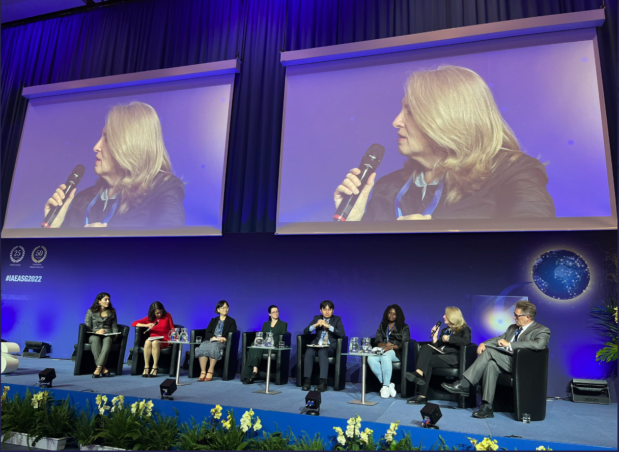
Ms. Sokova reflected on more than a decade of the VCDNP’s work as a hub for capacity building on nuclear issues, impact-driven research and results-oriented dialogue. She highlighted that, considering the dual technical‑political nature of safeguards, it is critical for diplomats and decision makers to understand how the safeguards system was developed and how it operates today. In this regard, Ms. Sokova noted the opportunities the VCDNP provides for capacity building, including through its short courses for diplomats and practitioners in the nuclear field.
In addition to its flagship intensive course on nuclear non-proliferation and disarmament for diplomats and practitioners, the VCDNP has begun to offer specialised courses, including a course on “Safeguards for Policymakers: What You Need to Know”. The specialised safeguards course, as well as a similar course on nuclear security, was the result of engagement with the IAEA and feedback provided by the Vienna-based diplomatic community.
Ms. Sokova also discussed the VCDNP’s work in fostering dialogue among key stakeholders in the safeguards and non‑proliferation community, noting the unique role of the non‑governmental organisations in bringing different groups together for dialogue on important issues. She gave the example of the VCDNP’s three‑part workshop series on strengthening nuclear safeguards and export controls to manage new challenges posed by advanced technologies.
Ms. Sokova described some of the VCDNP’s work in safeguards research, which is designed to provide timely information on critical issues facing the non-proliferation community. One example is a recent edition of the VCDNP’s Governing the Atom Brief Series on safeguards and naval nuclear propulsion, which seeks to clarify some of the legal and practical aspects of safeguarding naval nuclear propulsion programmes.
The first day of the Safeguards Symposium was dedicated to high‑level discussions on the evolution of the safeguards system to date. VCDNP Non‑Resident Senior Fellow Laura Rockwood participated in the panel “Reflecting on the Past”, which also featured two former IAEA Deputy Directors General for Safeguards.
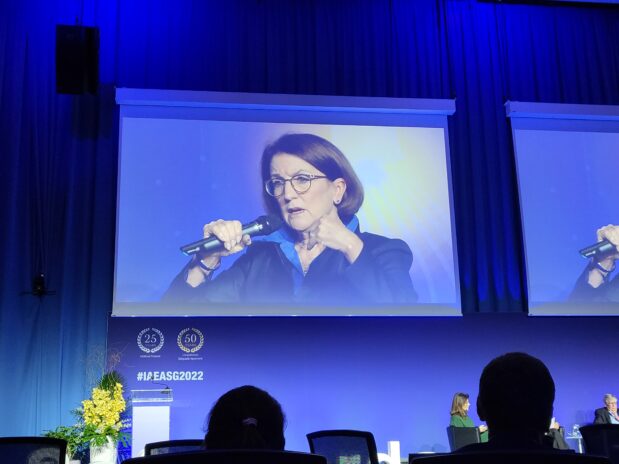
Ms. Rockwood focussed on the period of strengthening safeguards in the 1990s, which led to the adoption of the Model Additional Protocol. Although the need to strengthen safeguards was discussed during the 1990 Review Conference of the Treaty on the Non‑Proliferation of Nuclear Weapons (NPT), Ms. Rockwood observed that only following the discovery of a clandestine nuclear weapons programme in Iraq in 1991, the subsequent discovery of undeclared nuclear activities in North Korea and the revelation by South Africa of its dismantled nuclear weapons programme, did the drive to strengthen safeguards begin in earnest. Ms. Rockwood observed that these events produced a unity of purpose among Member States as to the need to strengthen safeguards. She also cited constant communication between the Secretariat and the IAEA’s Member States, and the competence and imagination of IAEA leadership, as contributing factors to the success of the Model Additional Protocol.
Ms. Rockwood also moderated a high‑level “Directors’ Panel” featuring Deputy Director General (DDG) and Head of the Department of Safeguards Massimo Aparo, the Chair of the Standing Advisory Group on Safeguards Implementation Irmgard Niemeyer, and Directors from every division in the Department of Safeguards.
During a panel discussion on “Adaptation and Resilience in the Non‑Proliferation Regime,” co-chaired by Gaukhar Mukhatzhanova, VCDNP Research Associate Noah Mayhew presented two papers submitted by the VCDNP for the Symposium. The first paper, by Mr. Mayhew, examined lessons learned from previous attempts to strengthen the safeguards system, including Programme 93+2 and Committee 24, the development of integrated safeguards, the approval by the Board of the modified text for small quantities protocols, and Committee 25. In particular, the paper analysed the reactive and proactive elements of each initiative with a view to identifying best practices for future attempts to strengthen safeguards.
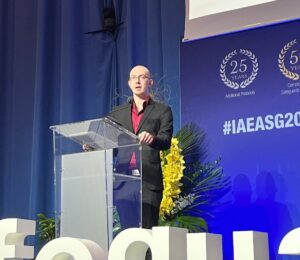
Mr. Mayhew highlighted four main lessons that emerged from the analysis of past initiatives:
The second paper, co-authored by Mr. Mayhew and the VCDNP Visiting Fellow Marianne Nari Fisher, focused on safeguards non‑compliance and the utility of the arbitration clause that is present in all comprehensive safeguards agreements. Mr. Mayhew discussed three takeaways from the paper.
The Symposium marked the 25th anniversary of the Model Additional Protocol with a set of panel discussions. Speaking in the session on “25 Years of the Model Additional Protocol and Prospects for the Future,” Mr. Mayhew discussed potential updates to the Annexes to the Protocol, drawing on the findings of an earlier VCDNP research project. The project entailed a technical analysis of technologies that are not covered in the Protocol’s Annexes but could still be considered significant in terms of safeguards planning, implementation and evaluation. It was conducted as a technical study to draw attention to the need to consider establishing an open‑ended working group of experts by the Board of Governors to consider possible amendments to the Annexes.
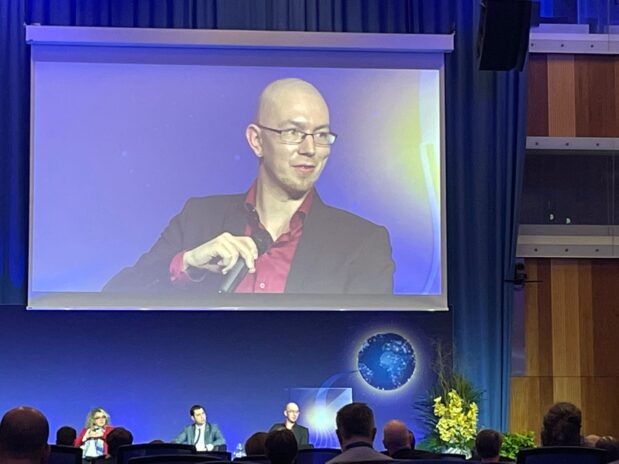
Mr. Mayhew presented lessons learned from consultations conducted as part of the project on political and procedural considerations that he argued would be important, should the Board establish the open‑ended working group. He discussed seven such lessons related to the establishment of the open‑ended working group, the group’s relationship with the Board, and the nature of potential amendments to the Annexes themselves.
Director of the International Organizations in Nonproliferation Program Ms. Gaukhar Mukhatzhanova spoke on a panel discussion on “Strengthening Confidence in the Absence of Undeclared Activities.” Ms. Mukhatzhanova noted that, while the 1990s saw intensive engagement by IAEA Member States in strengthening safeguards on both a technical and political basis, the debate on safeguards in multilateral forums became highly politicised in the mid-2000s. As an example, she observed that in the context of the NPT review process, the debate on the status of the Model Additional Protocol as part of the verification standard under Article III of the NPT has not progressed in more than a decade, and any conversation on further strengthening safeguards is likely to be controversial.
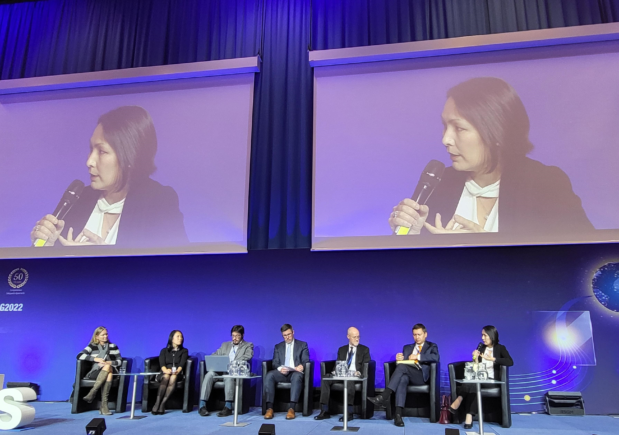
Ms. Mukhatzhanova argued that the IAEA Secretariat should be cognizant of this more hostile political environment and be proactive in engaging the Member States on further development and strengthening of the safeguards system, especially if it would require new legal authority. She emphasised the importance of trust and sustained communication between the Secretariat and Member States on safeguards implementation, as the international community faces new challenges and opportunities associated with various emerging technologies.
Ms. Rockwood discussed the legal aspects of non‑explosive nuclear uses in naval nuclear propulsion and space programmes during a session on “Safeguards for New Frontiers: Nuclear Applications at Sea and in Space.”
She noted that, as the NPT does not prohibit non‑explosive military uses of nuclear energy, the drafters of INFCIRC/153 – the basis for comprehensive safeguards agreements under the NPT – wanted to ensure that a commensurate provision was present in the document. However, they also wanted to ensure that such an allowance could not be used as a cover for the development of a nuclear weapons programme. This is why paragraph 14 of INFCIRC/153 describes the procedures that countries must follow if they wish to use nuclear material which is required to be safeguarded for a nuclear activity that does not require safeguards. Such uses notionally include nuclear propulsion at sea and in space.
Ms. Rockwood emphasised that paragraph 14 would have to be invoked before the withdrawal of any nuclear material from safeguards, and that a military‑to‑military transfer between two countries would not be a way to circumvent a paragraph 14 arrangement. She noted, there is no automatic exclusion from safeguards for nuclear material simply because it was already in, or produced for use in, a military activity. Second, according to international treaty law, a treaty cannot be interpreted in a such a way as would defeat its object and purpose – in other words, a State cannot simply claim material is in a military use and remove it from safeguards.
Overall, Ms. Rockwood emphasised the need to ensure that any arrangement for the non‑application of safeguards minimises the risk that an activity could be used to develop nuclear weapons, and that it is likely that the arrangement would need to be customised to that State’s nuclear fuel cycle, irrespective of which State is concerned.
Building on their joint project, the Nuclear Threat Initiative and the Center for Energy and Security Studies organised a side event, “The Future of IAEA Safeguards – Rebuilding the Vienna Spirit through Russia‑USA Expert Dialogue.”
Speaking at the event, Ms. Rockwood discussed sustainability in safeguards and how reinvigorated dialogue between the United States and the Russian Federation on safeguards could contribute. She noted that there has been a longstanding “coherence of views” between the two countries on the importance of safeguards that dates back to the negotiation of the NPT. In this regard, she argued that the IAEA Member States in general, and the United States and Russia in particular, should remain cognizant of their common interest in preventing further proliferation that would threaten international peace and security and might lead other States to pursue nuclear weapons.
Further, Ms. Rockwood remarked that confidence in and support for the IAEA Secretariat as an “instrument of peace” should be retained. Member States should provide political support to the IAEA’s Department of Safeguards by encouraging strong safeguards standards globally. Sustained US-Russian dialogue on safeguards matters is essential to ensure that, should disagreements arise, they do not damage the broader safeguards community.
In addition to papers and presentations delivered at the Symposium, the VCDNP contributed to efforts by the Symposium team to design potential future scenarios for the operating environment of the IAEA in 2057 – the Agency’s 100‑year anniversary. The purpose of this work was not to predict the future, but rather to design possible futures for the consideration of the Symposium participants so that the safeguards community can be proactive in shaping the actual future. As part of this process, a team of non‑governmental experts assisted the IAEA in identifying various drivers that affect the IAEA’s operating environment now and could in the future. The team identified three possible futures, each with its own experiential room at the Symposium where participants were asked to contribute further to developing the drivers.
Mr. Mayhew spoke during one of three panel discussions designed to bring attention to the futures work and the drivers that could inform the operating environment of the IAEA in 2057. This panel was focused on “The Great Game” future, driven by changes in the geopolitical balance, changing means of war and the changing role of the IAEA in the future. In this regard, Mr. Mayhew remarked on the “distressing trend” of the decline of the “Vienna Spirit” of compromise and consensus‑based decision making in the IAEA’s policymaking organs and called for a return to this practice.
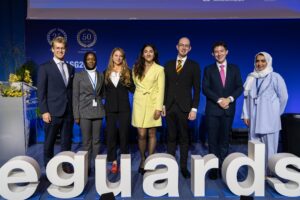
The last substantive panel of the Symposium was dedicated to the “Voices of the Future” and included young technical and policy experts in the safeguards community. Mr. Mayhew and his co‑panellists reflected on the current trends that are driving changes in the safeguards community today. The panel was joined by Deputy Director General and Head of the Department of Safeguards Massimo Aparo.


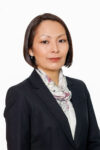

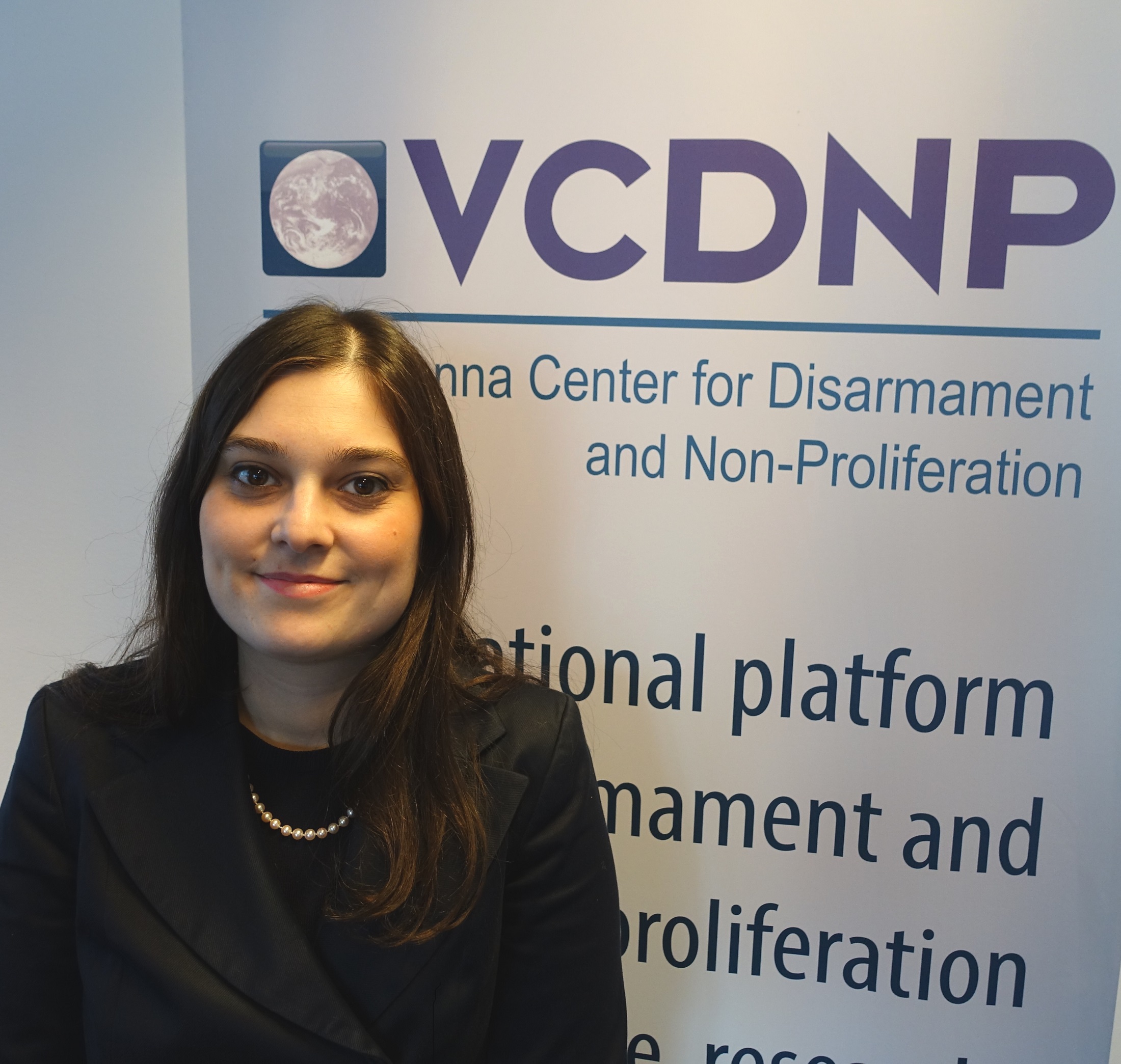
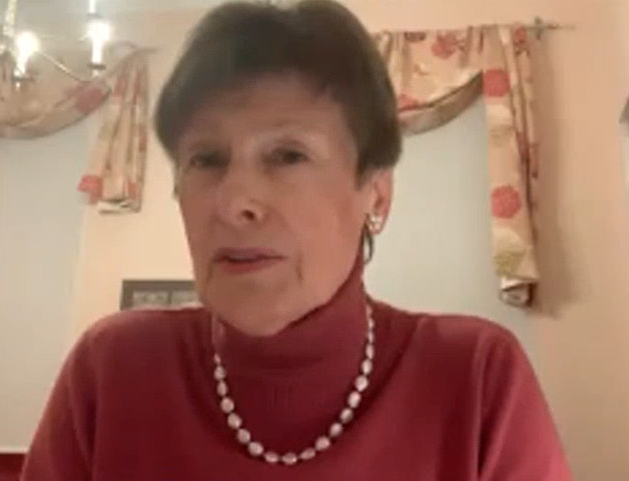
By continuing to use the site, you agree to the use of cookies. more information
The cookie settings on this website are set to "allow cookies" to give you the best browsing experience possible. If you continue to use this website without changing your cookie settings or you click "Accept" below then you are consenting to this.